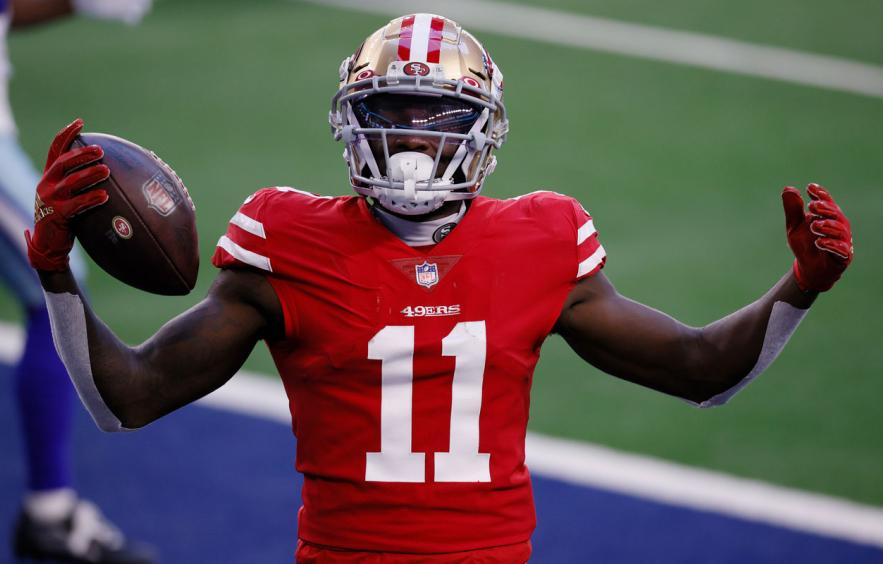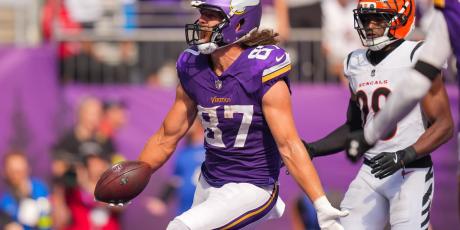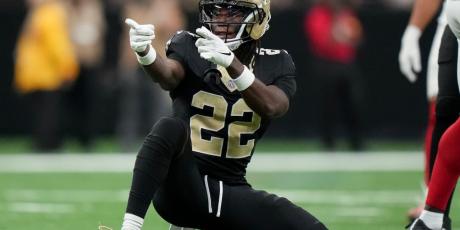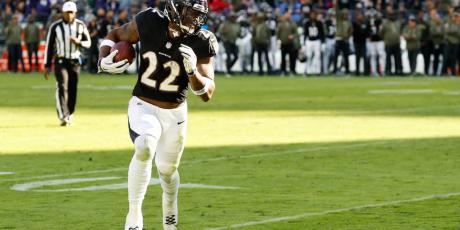Hoppen to Conclusions: Week 15 Insights and Analysis

Hello and welcome to the Week 15 edition of Hoppen to Conclusions! This is where I, Sam Hoppen, will share some of my favorite charts, which are designed to give you an overview of the NFL landscape. These charts, along with the commentary that I provide, aim to help you make start or sit DFS lineup construction, or any other fantasy football decisions. There can be a lot of noise in fantasy football analysis, but these charts have been carefully selected to give you some of the most relevant and useful decision points.
Each of the charts has been designed in a way that you want to be targeting players and teams that are in the top-right quadrant of the chart as denoted by the dotted black lines, which signify the median value for the stat on either the x-axis or y-axis. Before getting to each of the charts and analyses, here are some brief descriptions of what you will find on each chart and how to interpret them. As you can see, I have also added views on the last four weeks of games.
Note: neutral game-script is defined as plays outside of the two-minute warning with a win probability between 20% and 80% for the offensive team.
- Team Pace and Plays: Compares a team's average plays per game (in regulation only, overtime excluded) to its neutral-script pace, using seconds per play as a measure of pace. On the chart, the y-axis flipped to show faster-paced teams (fewer seconds per play) on top. Simply put, teams (and overall matchups) with more plays and faster pace will offer more opportunities for fantasy point-scoring.
- Team Pass Rates: Compares a team's pass rate over expectation (PROE) to its red-zone pass rate. Here we can identify which teams are passing the most when game script isn't a deciding factor and when they get close to the goal line.
- Running Back Usage: Compares running back snap percent to his high-value touches (carries inside the 10 and receptions), with the size of the player's point as his total opportunities per game.
- Wide Receiver/Tight End Usage: Compares player weighted opportunity rating (WOPR) to his targets per route run (TPRR), with the size of the player's point as his receiver air conversion ratio (RACR). WOPR weights both air yards share and target share to evaluate a player's opportunity, while RACR divides a player's receiving yards by his air yards to evaluate his efficiency in the opportunity he is given. The charts show the same information for both the wide receiver and tight end position.
Team Pace and Plays


- The New England Patriots head to Las Vegas on Sunday afternoon to exact revenge on Josh McDaniels leaving. On one side, you have the Raiders, who lack any urgency with the fifth-lowest no-huddle rate and the third-highest pace over expected, going up against a defense that now ranks second in EPA per play. On the other side, the Patriots' offense really misses McDaniels, as they rank 26th in EPA per play and have delivered just one game with more than 30 points scored.
- Action: bet under 44.5 (-107) on PointsBet
- My favorite game for Sunday's slate is the Jets and Lions game. New York's defense has been very good lately, one of the best in the league, but they face another tough challenge in the Lions, who rank third in EPA per play over the last four weeks. The Jets' offense, however, hasn't been super efficient, but they've had a lot of volume —in non-Zach Wilson games, the Jets average 289.5 pass yards per game, which would be second in the league. These teams both rank in the top half of the league in plays per game and have a negative pace over expected on the season.
- Action: target this game in DFS
Team Pass Rates


- The 49ers had a two-game stretch in Weeks 6 and 7 in which they had a positive PROE, but they've been negative in every week since. They haven't been forced to throw the ball, though, with the 4th-lowest expected pass rate over the last four weeks. This has created volume issues for 49ers pass catchers, but losing Deebo Samuel for a few weeks could make it easier for Brandon Aiyuk and George Kittle to maintain a solid workload.
- Action: start Brandon Aiyuk and George Kittle (and Samuel when healthy) as the only 49ers pass catchers
- Tampa Bay's 5.1% PROE since Week 11 is impressive because their 69.3% expected pass rate ranks second over that span. Tom Brady has thrown the ball at least 50 times in back-to-back games and reached that mark in five games total this year (the rest of the NFL has just 15 such games). Unfortunately, his -0.2% completion percentage over expectation has made it, so his pass-catchers haven't yielded high-value fantasy games.
- Action: start Chris Godwin and Mike Evans as the only Bucs wide receivers with confidence
- This week is Desmond Ridder's first NFL start, and I think we should expect a game plan similar to how Tennessee handled Malik Willis' two starts when they had a -28.3% PROE. Atlanta already runs it on 48.4% of their plays as the only team below 50% this year. New Orleans' defense has played decent this year, but they're a bit worse against the run as they rank 21st in Football Outsiders' rush defensive DVOA but 12th in pass defensive DVOA.
- Action: sit all Falcons pass catchers
Running Back Usage


- In Joe Mixon's return (following a two-game absence), he led the team in snap percent (57.1% to 38.1% for Samaje Perine). However, Perine had two more red zone snaps than Mixon (and the lone carry inside the 10) and was even with him on high-value touches.
- Action: start Samaje Perine as a flex
- The D'Andre Swift bump in usage may have been a mirage as he dipped down to just 10 opportunities in Week 14, while Jamaal Williams and Justin Jackson got 17 and five opportunities, respectively. Fortunately, Swift is still the primary receiving back, as he has earned at least three targets in each game since returning from injury and has dipped below a 30% route rate just once.
- Action: start D'Andre Swift and Jamaal Williams as flex options
- JK Dobbins' 15 opportunities on Sunday were just the fifth time this season that a Ravens running back earned that many opportunities, but Gus Edwards wasn't far behind with 13 opportunities. Dobbins had his most efficient day as a rusher, averaging 3.79 rushing yards over expected per carry (has been positive just one other time this year). But, with just one high-value touch in his last three games played, I struggle to put any sort of trust in Dobbins.
- Action: hold JK Dobbins
-
D'Onta Foreman had dominated Carolina's backfield prior to the bye week, as he had a 53.9% snap share and 66% of the backfield's carries. He returned with a 21-carry outing and three carries inside the ten, but failed to convert any of them into a touchdown. Meanwhile, Chuba Hubbard (14 carries) found the end zone on his lone carry inside the five and looks to have secured the pass-catching work with three targets and playing on 84.6% of the team's third-down snaps.
- Action: add Chuba Hubbard
Wide Receiver Usage


- Though he is now in concussion protocol, Richie James has been solid over the last month, with 13+ PPR points in three of his last four games. He's second on the team over that span of four games with an average of 5.2 targets per game, but he's only run a route on 58.7% of dropbacks (his 93.2% rate in Week 14 was a season-high). Darius Slayton remains the WR1 (20.6% target share last four weeks), and Isaiah Hodgins has run a route on at least 80% of the team's dropbacks in back-to-back games, with just one fewer target than James since Week 10.
- Action: add Richie James or Isaiah Hodgins if you're desperate for WR production
- The headline Sunday night was Tua vs. Herbert, but that overshadowed Mike Williams' return. Los Angeles looks like they may have eased him back (74.5% routes run rate) and only had six targets, but he led the team with 112 receiving yards and caught a spectacular touchdown. Conversely, Keenan Allen now has 14 targets in back-to-back games and looks like he's back to his old ways. Most importantly, both Allen and Williams escaped this game without suffering an injury setback.
- Action: buy Mike Williams
- Welcome to the NFL, Jameson Williams! Though everyone (myself included) is excited about Williams' NFL future, I need to pour a little cold water on his fantasy value. In his first two weeks back, he has run just eight total routes. Getting three targets on those eight routes is solid, but DJ Chark has been the team's primary deep threat (16.7-yard aDOT) this season, and it looks like he's fully recovered from his ankle injury with back-to-back 90-yard receiving games.
- Action: sell Jameson Williams
- In the post-Cooper Kupp and Allen Robinson era, we've seen the Rams spread out their opportunities. Tutu Atwell, Ben Skowronek, and Van Jefferson have 16, 14, and 14 targets, respectively, over the last three weeks. Jefferson (95.2%) and Skowronek (80.8%) lead the team in routes run percent in those games, while Atwell (53.8%) is much further behind. Even though Baker Mayfield provided a moral boost last week, this distribution is too spread out, and the Rams are too bad to want any piece of them.
- Action: fade all Rams wide receivers
- Recently, the Browns have become one of the more concentrated passing attacks. They've still remained run-first with PROE marks of -17% and -2.2% in the first two weeks with Deshaun Watson. But Amari Cooper and Donovan Peoples-Jones are the only Browns wide receivers running a route on at least 55% of dropbacks this season and averaging more than three targets per game.
- Action: buy Amari Cooper and Donovan Peoples-Jones
Tight End Usage


-
Cade Otton looks like he may have officially supplanted Cameron Brate as the TE1 in Tampa Bay. Though he's missed some games due to injury, Brate has out-targeted Otton in just one game since Week 5. Otton has only run a route on about 67% of the team's dropbacks, which isn't great, but I still think he's worth an add.
- Action: add Cade Otton
- I'm still not buying what Dawson Knox is selling. Knox has more games with 10 or fewer receiving yards than he has with more than 45 receiving yards. His route rate has spiked recently as he's gone above the 80% mark in three of his last four games, but adding Cole Beasley to the Bills will create even more competition when Knox has gone over a 20% target share just twice this season.
- Action: fade Dawson Knox



















